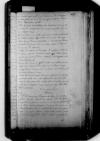List #5744
Alfonso de VALDÉS do Ioannes DANTISCUSPalencia, [1527]-09-10
Regest polski: Valdes żałuje decyzji o przeniesieniu się z Cubillas de Cerrato do Palencji – nie podoba mu się miejsce, nie znalazł gospody, wszyscy intrygują tu przeciwko starcowi [kanclerzowi Gattinarze]. Nie wyjechałby tak pochopnie, gdyby Dantyszek przebywał z nim w Cubillas. Nie widział listu do prepozyta [Baltasara Merklina von Waldkirch]. Cieszy się ze znajomości Dantyszka z Marliano, przekazuje dla niego pozdrowienia. Przekazuje niepewne wiadomości na temat Genui, jakoby zajęli ją Francuzi, dziwi go, że kanclerz [Mercurino Gattinara] nie wspomina o tym w liście z 4 września z Barcelony i nie informuje o tym także cesarza. Kanclerz od wigilii święta Narodzenia Maryi Panny [tj. od 7 września] ma zamiar przebywać przez 9 dni w [klasztorze] Monserrat, a następnie przybyć na dwór. [Arcybiskup] York'u [Thomas Wolsey] zawarł w imieniu swego króla [Henryka VIII] z królem Francji ścisłe przymierze, wymierzone w cesarza. Poseł Borbonius wyjechał wczoraj naprzeciw kanclerzowi. Przekazał pozdrowienia dla Dantyszka.
| odebrano Paredes de Nava, [1527]-09-10 Rękopiśmienne podstawy źródłowe:
Pomocnicze podstawy źródłowe:
Publikacje:
| ||||||||||||||||||||
Tekst + aparat krytyczny + komentarzZwykły tekstTekst + komentarzTekst + aparat krytyczny
Excellentissimo viro, domino
Salutem plurimam.
Valebamus quidem nos quam rectissime in
Litteras ad dominum
Scribit
Rerum hic novarum offendi nihil, nisi
Orator Borbonius discessit heri versus
Haec pauca ad te scribere volui, tu ea boni consules, sum enim et hospitio et sensu etiam privatus. Vale.
Palentiae, 10 Septembris 1527.
Tuus, quicquid est,
[1 ] As regards missions of Nicolas Perrenot de Granvelle to Francis I cf. e.g. Kohler 2000, p. 128

